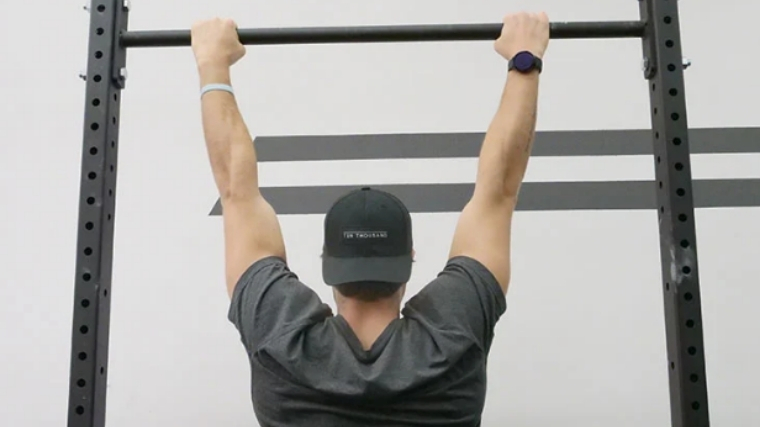If you’ve been stuck at the same pull-up count for weeks or feel like your back isn’t growing no matter how often you train, this 10-minute pull-up protocol is going to change everything. It’s short, brutal, and surprisingly effective.
Whether you can crank out 15 reps or struggle to do even one, this method works because it hits your back with strategic volume and intensity without burning you out. Plus, it fits into even the busiest schedule.
Let’s break it down so you know exactly how to do it, how to scale it to your level, and why it builds serious back muscle and pull-up power.
Why Focus on Pull-Ups for Back Gains?
Pull-ups aren’t just for showing off. They’re one of the best compound movements you can do to grow your:
- Lats (the big wings of your back)
- Traps and rhomboids
- Biceps and forearms
- Core muscles
- Grip strength
If your goal is to build a wide, muscular back, pull-ups need to be a staple. And this protocol maximizes the movement in the least amount of time.
What Is the 10-Minute Pull-Up Protocol?
This routine uses density training. That means you’re trying to get as much quality work done in 10 minutes as possible—without hitting failure too soon.
Here’s the basic setup:
Timer: 10 minutes
Goal: Perform sets of 3–5 pull-ups every 30–45 seconds
Rest: Whatever’s left in each 30–45 second window
Progress: Try to increase reps or reduce rest week to week
It’s simple, scalable, and brutally effective.
Step-by-Step Breakdown
Step 1: Choose Your Rep Range
If you’re a beginner: Start with 2–3 pull-ups per round
If you’re intermediate: Stick with 4–5 pull-ups
If you’re advanced: Go 6–8 reps per round and cut rest time to 20–30 seconds
You don’t want to go to failure. Instead, you want to maintain good form and hit clean reps.
Step 2: Set a Timer for 10 Minutes
This is your total work time. You’re not doing one big set—you’re doing many small sets with short rests. Think of it like a high-quality circuit.
Step 3: Keep Moving
Your goal is to stay consistent. You’ll probably start strong and feel your arms burning by minute 6. That’s normal. Try to hold your rep count all the way to the end.
If you get fatigued, cut reps but don’t stop moving. Even one pull-up per round is better than stopping.
What If You Can’t Do a Full Pull-Up Yet?
No problem. Here are beginner-friendly variations you can plug into the same 10-minute format:
- Assisted pull-ups with resistance bands
- Negative pull-ups (jump up, lower down slow for 3–5 sec)
- Bodyweight rows using a barbell in a squat rack or TRX
Use the same timer and interval strategy. Just make sure the variation still challenges your back.
Why This Protocol Works
This method builds your back in three ways at once:
1. Volume Without Overkill
By breaking up your sets and spreading them over 10 minutes, you build total training volume without gassing out in one go.
Volume is king for muscle growth—and this method keeps it manageable.
2. Mechanical Tension
Every rep in this format is high-quality. You’re not swinging or cheating your way through sets. That controlled tension is what tells your back muscles, “Hey, time to grow.”
3. Frequency Friendly
Because this is only 10 minutes and avoids failure, you can do it 3–4 times per week. That’s way more effective than just one pull-up day.
Sample 10-Minute Pull-Up Workout for Each Level
Beginner
- 10 minutes of assisted pull-ups
- 2 reps every 45 seconds
- Goal: 13 sets = 26 total reps
Intermediate
- 10 minutes of bodyweight pull-ups
- 4 reps every 40 seconds
- Goal: 15 sets = 60 total reps
Advanced
- 10 minutes of weighted pull-ups
- 5 reps every 30 seconds
- Goal: 20 sets = 100 total reps
Scale as needed. Keep your form clean and your rest periods honest.
Bonus: Add Variety for Even More Gains
Pull-ups are versatile. If you repeat this protocol 3–4 times per week, you can cycle through variations to hit different back angles:
- Wide grip – for broader lats
- Close grip/chin-ups – for biceps and lower lats
- Neutral grip – great for joints and mid-back
- Archer or commando pull-ups – for advanced control
Swap in new variations every week or two to avoid boredom and challenge your muscles in new ways.
Recovery Matters
Because this is a short but intense workout, don’t ignore recovery:
- Stretch your lats post-workout (use a doorway or bar)
- Eat enough protein (at least 1.6g per kg of bodyweight)
- Sleep at least 7 hours to let your muscles grow
- Stay consistent—progress stacks fast when you stick with it
How to Track Progress
Each week, log:
- Total reps completed in 10 minutes
- The variation you used (assisted, banded, weighted, etc.)
- Your rest interval (aim to reduce rest over time)
- How the sets felt (RPE score, 1–10)
By week 4, you should see real progress: higher rep counts, less rest needed, better form, or even moving to a tougher variation.
Final Word: The 10-Minute Pull-Up Trick That Actually Works
Don’t let long workouts or complicated routines stop you from building a bigger, stronger back. This 10-minute pull-up protocol keeps things focused, efficient, and effective.
You’ll build pulling strength, pack size onto your lats, and boost your pull-up count—without spending an hour at the gym.
Start small, stay consistent, and watch your pull-ups go from “eh” to elite in just a few weeks.










